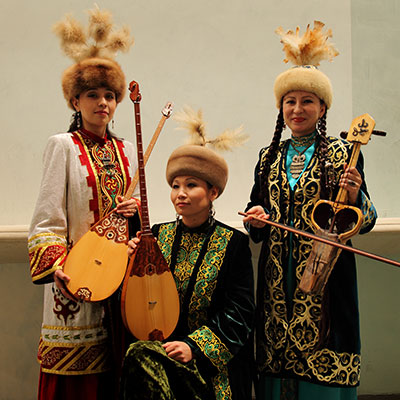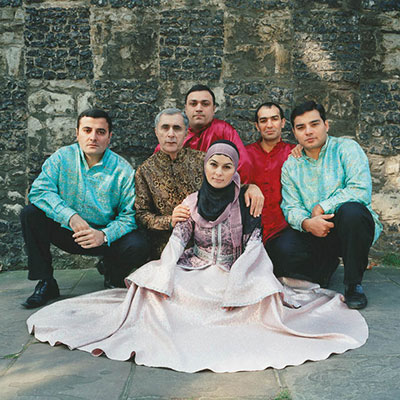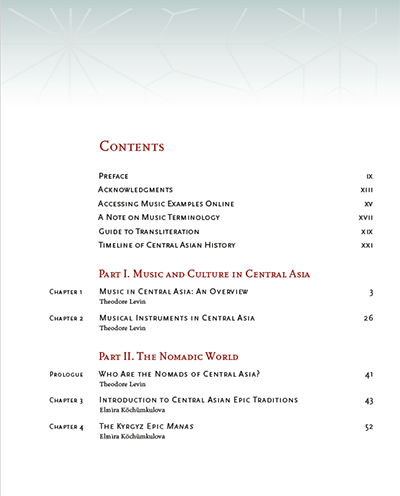


About The Music of Central Asia
This website serves as a companion to the print edition and e-book version of The Music of Central Asia, edited by Theodore Levin, Saida Daukeyeva, and Elmira Köchümkulova (Indiana University Press, 2015). Its contents include:
- Audio and video tracks that illustrate the music examples described in the book.
- Transcriptions and translations of long poetic texts that could not be included in the print edition.
- A guide to additional resources for the study of music from Central Asia (Further Reading, Listening, and Viewing).
About The Music of Central Asia
The Music of Central Asia surveys the rich and diverse musical life of a region once at the center of the trans-Eurasian Silk Road trade that has reemerged in our own time as a crucial arena of global geopolitics. Developed both as a resource for Central Asians to learn about the musical heritage of their own region and to introduce this heritage to readers and listeners worldwide, The Music of Central Asia balances “insider” and “outsider” perspectives contributed by 27 authors from 14 countries. A principal feature of the book is this companion website through which readers may access 189 audio and video examples accompanied by listening guides and study questions, and by transliterations and translations of performed texts. Generously illustrated and formatted with call-out boxes, side bars, musician profiles, and an illustrated musical instrument glossary, The Music of Central Asia targets a broad, nonspecialist readership while also serving as an indispensable resource for specialists. The book is divided into four major sections: an overview of the region’s music and musical instruments; sections on “The Nomadic World” and “The World of Sedentary-Dwellers,” which explore music and musical life in the context of Central Asia’s two great axes of civilization; and “Central Asia in the Age of Globalization,” whose focus is “the future of the past,” or how musical heritage is being revitalized and reimagined in the contested cultural landscape of contemporary Central Asia. The Music of Central Asia can be used as a textbook—read systematically to build comprehensive knowledge about interlinked topics—or approached as a reference work for information on specific musical styles, repertoires, and traditions. The book’s 35 chapters offer ample material for a semester-long course, while groups of chapters can serve as a module in courses devoted to broader topics in music, history, and culture.Using the Website
To view or listen to a music example, scroll down to the chapter that contains the example, and then click on the example number. Video and audio tracks are each identified by a distinctive icon.
Chapters 1-3 (Music in Central Asia: An Overview; Musical Instruments in Central Asia; Intrduction to Central Asian Epic Traditions) do not include audio or video examples, and thus are not represented in the table of contents on this website.
In viewing and listening to the music examples, readers should keep in mind that the majority of these examples were recorded in the field--most of them by music ethnographers using audio and video equipment available to them at the time. The quality of this equipment varies, and older recordings in particular betray the technical limitations of some of the equipment that was used. Nonetheless, older recordings have been included where the material they present is historically important. Part of the goal of listening to such recordings is to be able to "extract" the music itself from the technical limitations of its mediated reproduction.
About the Aga Khan Music Initiative
The Co-editors and Indiana University Press gratefully acknowledge the support of the Aga Khan Music Initiative, a program of the Aga Khan Trust for Culture, in creating and maintaining this website.
The Aga Khan Music Initiative is an interregional music and arts education program with worldwide performance, outreach, mentoring, and artistic production activities. The Initiative was launched by His Highness the Aga Khan to support talented musicians and music educators working to preserve, transmit, and further develop their musical heritage in contemporary forms. The Music Initiative began its work in Central Asia, with projects in Kazakhstan, Kyrgyzstan, Tajikistan and Afghanistan, and subsequently expanded its cultural development activities to include artistic communities and audiences in the Middle East and North Africa, South Asia, and West Africa. The Initiative designs and implements a country-specific set of activities for each country into which it invests, and works to promote revitalization of cultural heritage both as a source of livelihood for musicians and as a means to strengthen pluralism in nations where it is challenged by social, political, and economic constraints.
For more information, see http://www.akdn.org/music

 For more information, see
For more information, see